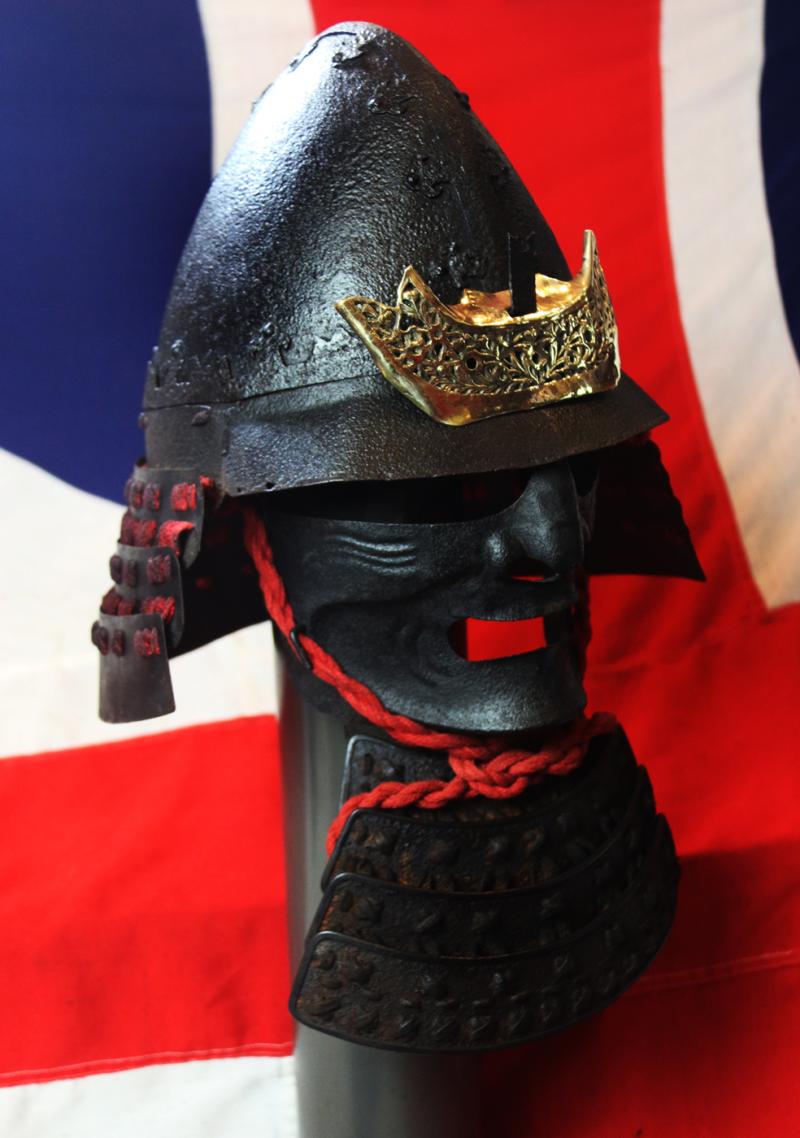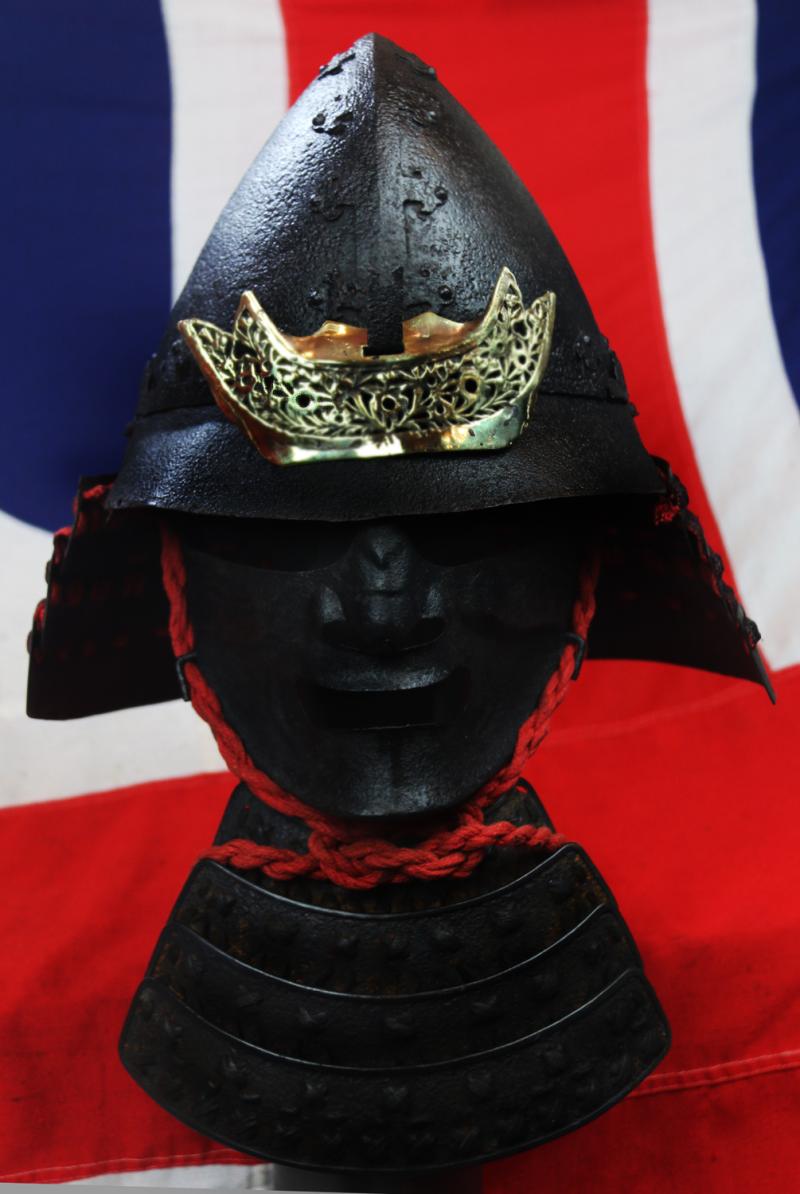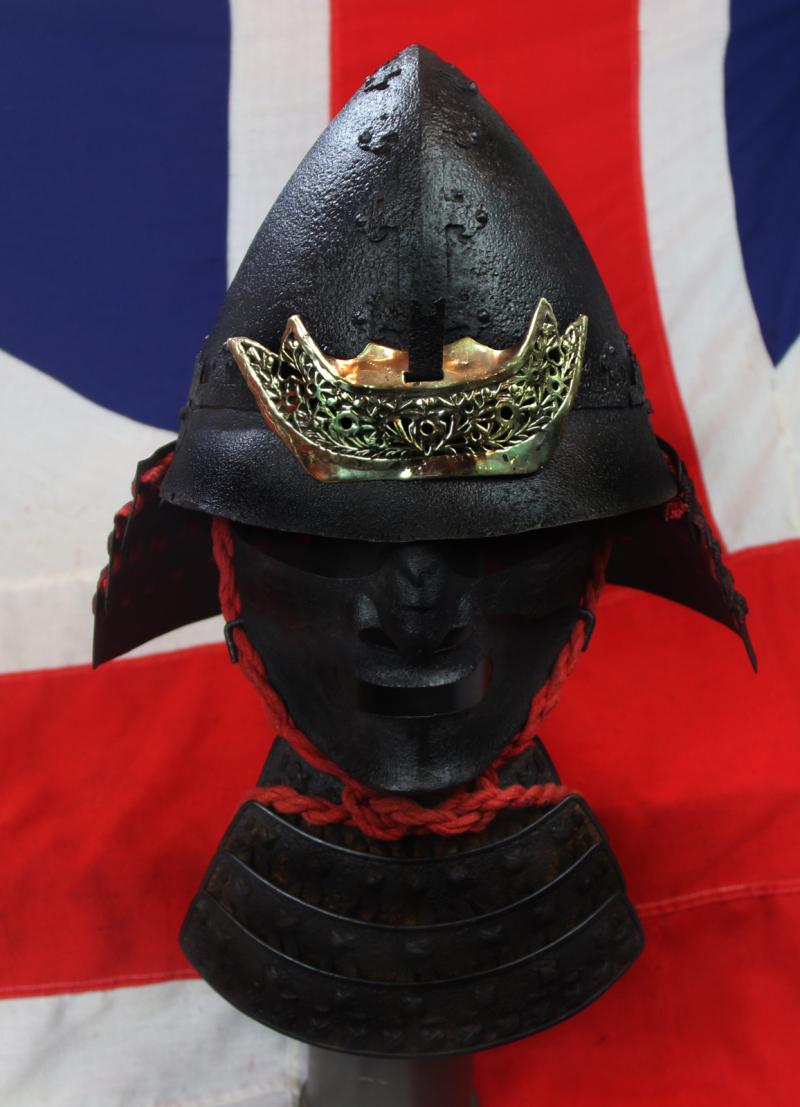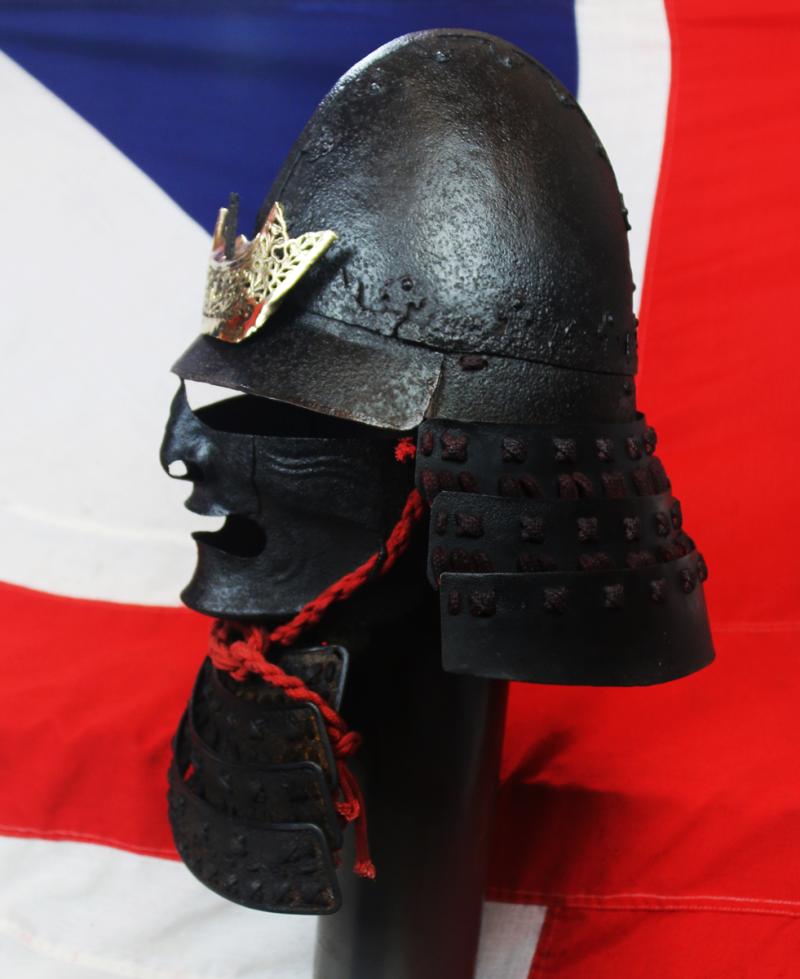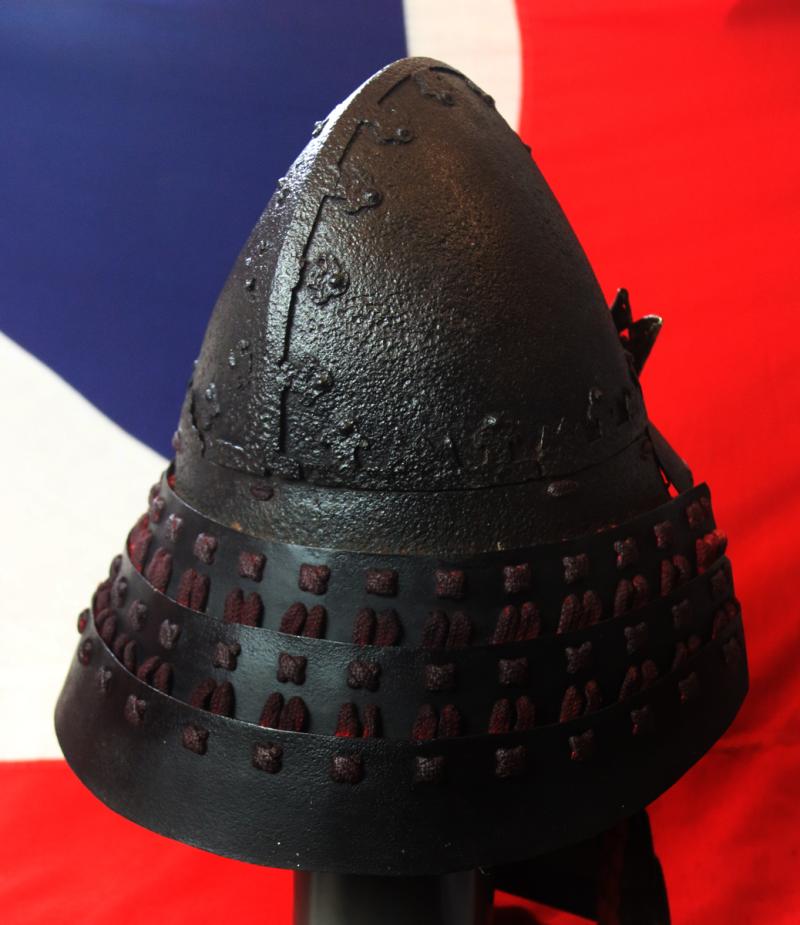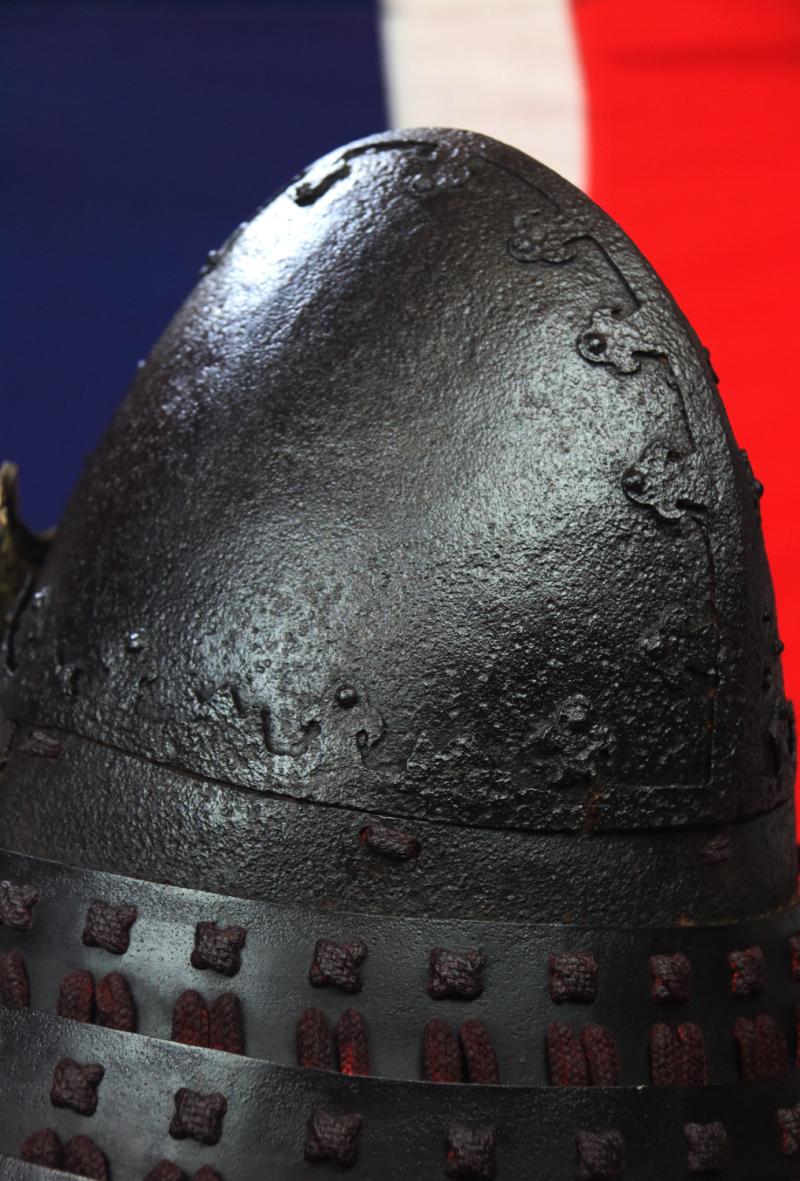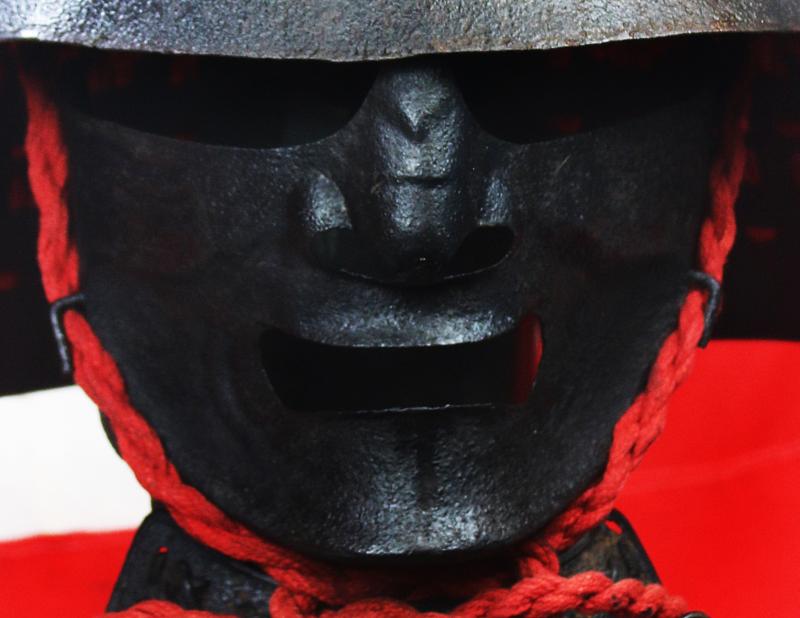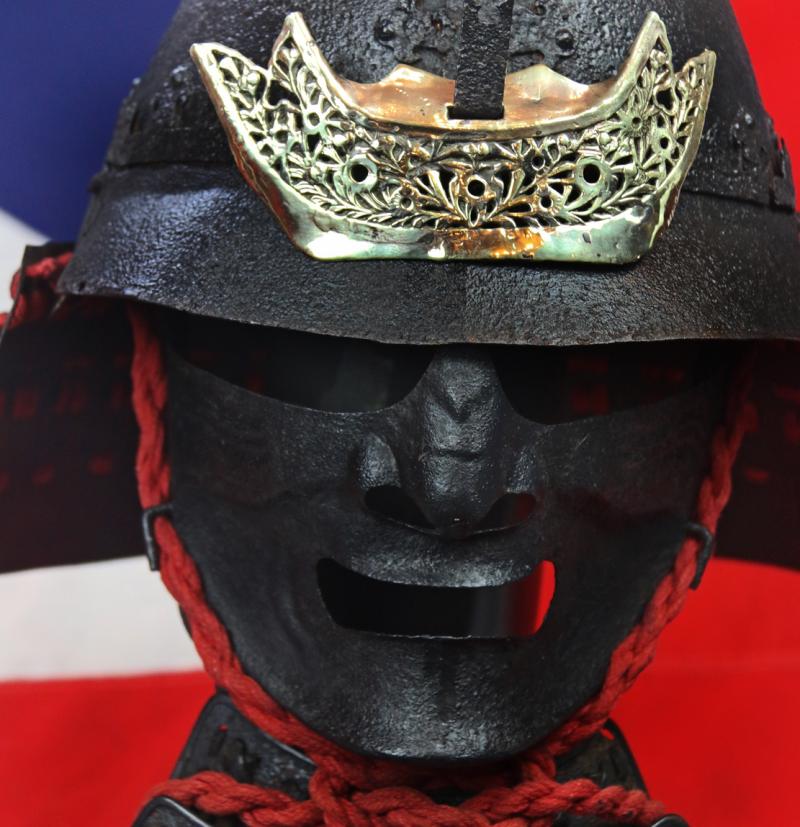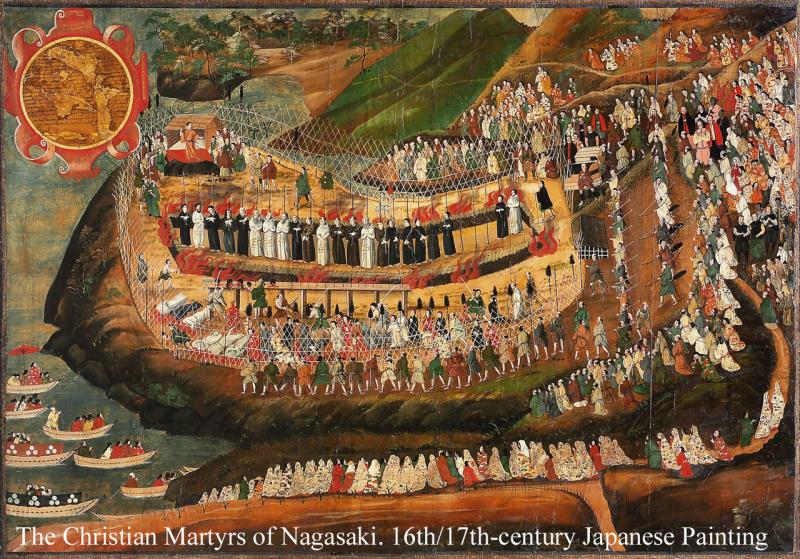A Beautiful and Most Impressive Nanban-Nari Kabuto High Conical Samurai Helmet. Likely of A Christian Samurai, Known As Krishitan, Momoyama to Edo Period. With Menpo Face Armour
A Nanban-nari, Christian decorated high conical helmet, with a koshi-no-ita base plate encircles the lower section of the skull, decorated around the border and across the apex with European form strap work with applied rivetted Catholic fleur-de-lys decor, a visor, or tousei mabisashi, is fitted to the front. Three-tiered black lacquer shikoro neck guard with sugake odoshi spaced lacing in very dark red braid. A tatsu tsunomoto holder for the maedate helmet crest, and a maedate in very decoratively pierced sinchu, brass alloy resembling gold. The maedate is of the form with slots that can have optional wakedate flat horns fitted.
The helmets fully embellished fleur-de-lys decor is a symbol of the 16th century Catholic Church, specifically Mary the Virgin. From antiquity it has been the symbol of purity and was readily adopted by the Roman Catholic church to associate the sanctity of Mary with events of special significance. The lily was said to have sprung from the tears shed by Eve as she left Eden. Thus, when Pope Leo III in 800 crowned Charlemagne as emperor, he is reported to have presented him with a blue banner covered (semé) with golden fleurs-de-lis.
The kabuto has a matching form Menpō face armour, that covered the face from the top of the nose down to the chin, with four rows of yodare-kake, throat guard armour. An early syle affixed and none removable nasal cover. All the main helmet and menpo surfaces, {except the shikoro} are in Higo russetted form.
Every year oir so we are delighted to acquired samurai swords with hidden Christian {Kakure Kirishitan} symbology, such as tsuba with pierced crucifix within in their designs, but we cannot recall ever seeing a Krishitan symbolised kabuto over these past 50 years. Only in Japanese museums, and very few of these.
The Nanban-nari Kabuto was introduced from the West during the Warring States period. Because it imitates the shape of a hat, it was called a “Nanban hat helmet”. Only the helmets bowl (Hachi ) was Nanban, other parts like Shikoro and Mabisashi were made and designed domestic style. This brand new kind of helmet was very popular at the time of introduction.
Nanban, In Japanese literally means “southern Barbarians”, actually refers to Europeans, because they came from the south of Japan. The helmets of the Europeans, Spanish and Portuguese, were of the morion or cabassat form. These new ‘barbarians’ not only brought Catholic monks to convert the samurai and their vassal peasants to Christianity, but their muskets, cannon, armour, leather, and clothing became de-riguer to influence everything from decor fashion armour and clothing. Especially amongst the converted daimyo lords, his family, and his samurai.
Face armour in Japan begins with the happuri, which is depicted in Heian- and Kamakura-era yamato-e paintings, and is thought to have appeared during the 10th or 11th centuries.It is depicted as being worn with or without a helmet by both mounted warriors and foot retainers. By the 14th century, the hōate appears, and according to Tom Conlan, this development is behind decreased facial wound statistics. However, others, such as Yamagishi Sumio, believe that the hōate was not widespread at that time, as it—and the later menpō—restricted the vision of the wearer. Hōate are also portrayed in art and literature of the period, most notably the Aki no yo no Nagamonogatari scroll and Taiheiki. The menpō (half-mask with detachable nosepiece) and the sōmen (full face mask) are believed to have been introduced around the mid to late 15th century, and the hanbō (chin guard) in the second half of the 16th century.
The current FX series 'Shogun' by Robert Clavell is based on the true story of William Adams and the Shogun Tokugawa Ieyesu, and apart from being one of the very best film series yet made, it shows superbly and relatively accurately the machinations of the Catholic Jesuits to manipulate the Japanese Regents and their Christian convert samurai Lords.
Oda Nobunaga (1534–82) had taken his first step toward uniting Japan as the first missionaries landed, and as his power increased he encouraged the growing Kirishitan movement as a means of subverting the great political strength of Buddhism. Oppressed peasants welcomed the gospel of salvation, but merchants and trade-conscious daimyos saw Christianity as an important link with valuable European trade. Oda’s successor, Toyotomi Hideyoshi (1537–98), was much cooler toward the alien religion. The Japanese were becoming aware of competition between the Jesuits and the Franciscans and between Spanish and Portuguese trading interests. Toyotomi questioned the reliability of subjects with some allegiance to the foreign power at the Vatican. In 1587 he ordered all foreign missionaries to leave Japan but did not enforce the edict harshly until a decade later, when nine missionaries and 17 native Kirishitan were martyred.
After Toyotomi’s death and the brief regency of his adopted child, the pressures relaxed. However, Tokugawa Ieyasu, who founded the great Tokugawa shogunate (1603–1867), gradually came to see the foreign missionaries as a threat to political stability. By 1614, through his son and successor, Tokugawa Hidetada, he banned Kirishitan and ordered the missionaries expelled. Severe persecution continued for a generation under his son and grandson. Kirishitan were required to renounce their faith on pain of exile or torture. Every family was required to belong to a Buddhist temple, and periodic reports on them were expected from the temple priests.
By 1650 all known Kirishitan had been exiled or executed. Undetected survivors were driven underground into a secret movement that came to be known as Kakure Kirishitan (“Hidden Christians”), existing mainly in western Kyushu island around Nagasaki and Shimabara. To avoid detection they were obliged to practice deceptions such as using images of the Virgin Mary disguised as the popular and merciful Bōsatsu (bodhisattva) Kannon, whose gender is ambiguous and whom carvers often render as female.
The populace at large remained unaware that the Kakure Kirishitan managed to survive for two centuries, and when the prohibition against Roman Catholics began to ease again in the mid-19th century, arriving European priests were told there were no Japanese Christians left. A Roman Catholic church set up in Nagasaki in 1865 was dedicated to the 26 martyrs of 1597, and within the year 20,000 Kakure Kirishitan dropped their disguise and openly professed their Christian faith. They faced some repression during the waning years of the Tokugawa shogunate, but early in the reforms of the emperor Meiji (reigned 1867–1912) the Kirishitan won the right to declare their faith and worship publicly.
The interior lining and cords of this kabuto have been replaced in the past 100 years
Code: 25202

